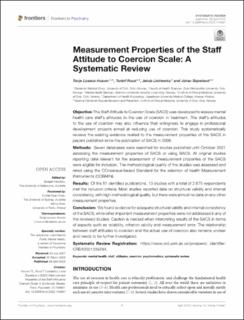| dc.contributor.author | Husum, Tonje Lossius | |
| dc.contributor.author | Ruud, Torleif | |
| dc.contributor.author | Lickiewicz, Jakub | |
| dc.contributor.author | Siqveland, Johan | |
| dc.date.accessioned | 2022-11-28T09:59:21Z | |
| dc.date.available | 2022-11-28T09:59:21Z | |
| dc.date.created | 2022-10-20T10:10:04Z | |
| dc.date.issued | 2022-04-28 | |
| dc.identifier.citation | Frontiers in Psychiatry. 2022, 13 . | en_US |
| dc.identifier.issn | 1664-0640 | |
| dc.identifier.uri | https://hdl.handle.net/11250/3034395 | |
| dc.description.abstract | Objective: The Staff Attitude to Coercion Scale (SACS) was developed to assess mental health care staff’s attitudes to the use of coercion in treatment. The staff’s attitudes to the use of coercion may also influence their willingness to engage in professional development projects aimed at reducing use of coercion. This study systematically reviews the existing evidence related to the measurement properties of the SACS in papers published since the publication of SACS in 2008.
Methods: Seven databases were searched for studies published until October 2021 assessing the measurement properties of SACS or using SACS. All original studies reporting data relevant for the assessment of measurement properties of the SACS were eligible for inclusion. The methodological quality of the studies was assessed and rated using the COnsensus-based Standard for the selection of health Measurement INstruments (COSMIN).
Results: Of the 81 identified publications, 13 studies with a total of 2,675 respondents met the inclusion criteria. Most studies reported data on structural validity and internal consistency, with high methodological quality, but there were almost no data on any other measurement properties.
Conclusion: We found evidence for adequate structural validity and internal consistency of the SACS, while other important measurement properties were not addressed in any of the reviewed studies. Caution is needed when interpreting results of the SACS in terms of aspects such as reliability, criterion validity and measurement error. The relationship between staff attitudes to coercion and the actual use of coercion also remains unclear and needs to be further investigated. | en_US |
| dc.language.iso | eng | en_US |
| dc.publisher | Frontiers Media | en_US |
| dc.relation.ispartofseries | Frontiers in Psychiatry;April 2022 | Volume 13 | Article 744661 | |
| dc.rights | Navngivelse 4.0 Internasjonal | * |
| dc.rights.uri | http://creativecommons.org/licenses/by/4.0/deed.no | * |
| dc.subject | Mental health | en_US |
| dc.subject | Staff | en_US |
| dc.subject | Attitudes | en_US |
| dc.subject | Coercion | en_US |
| dc.subject | Psychometrics | en_US |
| dc.subject | Systematic reviewing | en_US |
| dc.title | Measurement Properties of the Staff Attitude to Coercion Scale: A Systematic Review | en_US |
| dc.type | Peer reviewed | en_US |
| dc.type | Journal article | en_US |
| dc.description.version | publishedVersion | en_US |
| dc.rights.holder | © 2022 Husum, Ruud, Lickiewicz and Siqveland | en_US |
| dc.source.articlenumber | 744661 | en_US |
| cristin.ispublished | true | |
| cristin.fulltext | original | |
| cristin.qualitycode | 1 | |
| dc.identifier.doi | https://doi.org/10.3389/fpsyt.2022.744661 | |
| dc.identifier.cristin | 2063105 | |
| dc.source.journal | Frontiers in Psychiatry | en_US |
| dc.source.volume | 13 | en_US |
| dc.source.issue | 13 | en_US |
| dc.source.pagenumber | 1-8 | en_US |

